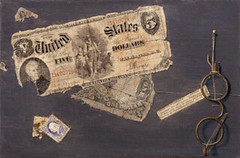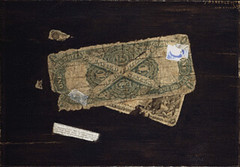
PREV ARTICLE
NEXT ARTICLE
FULL ISSUE
PREV FULL ISSUE
JOHN HABERLE: AMERICAN MASTER OF MONEY PAINTINGS
Kay O. Freeman forwarded this article about John Haberle, a master painter whose realistic pictures of money roused the interest of the U.S. Secret Service.
-Editor
By the early 1880s, Haberle had acquired skills as a draftsman and engraver that prepared him for a career as an illusionistic painter capable of creating visual artistic jokes. Such work was much prized by businessmen, who hung works on their office walls for amusement and bragging rights, and for display in taverns and other places frequented by men. Although classified as a trompe l'oeil artist, Haberle referred to his style as "artistic mechanics."


At a time when counterfeiting was serious business — the US Secret Service was established in 1865 to suppress bogus money — paintings featuring US currency were very popular, particularly to decorate saloons. Harnett created the first American currency painting in 1877. When his precisely delineated works were displayed in a New York saloon in 1886, the Secret Service warned him to stop painting money, and Harnett complied. Haberle, on the other hand, took up the subject with gusto, making US currency a specialty. In 1887, he exhibited a money painting, "Imitation," at the National Academy of Design. Its painstakingly painted stamps and Treasury notes remain convincing on close inspection. A small tintype of the bewhiskered artist underscores the identity of its creator. (Adjacent display cases contain original currency, stamps and photographs similar to those reproduced in several of Haberle's paintings, including "Imitation.") The purchase of "Imitation" by prominent art collector Thomas Clarke and its subsequent display at the Pennsylvania Academy of the Fine Arts encouraged the painter to continue using money themes in his work. Clarke, who continued to collect and promote the painter's work, said, "No artist has yet equaled Haberle in imitating bills and stamps." Haberle's next complex canvas on the subject, "Reproduction," containing currency and stamps and readable newspaper clippings alluding to counterfeiting charges, was exhibited at the Art Institute of Chicago that same year, 1887. It was "U.S.A. (The Chicago Bill Picture)," circa 1889, showing a worn $1 bill atop a tattered $10 note, a one-cent stamp, a piece of tape and a newspaper clipping praising "Imitation" that caused the uproar that brought Haberle to national attention. While "U.S.A." was on display at the Art Institute of Chicago in 1889, a local newspaper critic accused Harberle of perpetuating a fraud by pasting real currency and stamps onto his canvas. Incensed, the artist traveled to Chicago to confront the writer. Using a magnifying glass and paint remover, experts proved the image was indeed fully painted. Within days, the critic retracted his charge, calling the canvas a "true work of imitative art." Dubbed by one art historian as an "ironic and comedic tour de force," "U.S.A." deliberately sought to goad the government by including the $1 bill's reverse side with its official warning against imitation of US currency. For years it hung in one of Detroit's male-only saloons. "U.S.A." and its attendant brouhaha solidified Haberle's reputation as the most meticulous painter of currency. In other nearly perfectly rendered views of currency, Haberle continued to depict the warning against counterfeiting on the reverse side of the $1 bill. This ploy suggests that the artist was neither shy nor humble about his skills nor afraid of its consequences. When the US Treasury warned him to stop painting money, he just painted more detailed and accurate images. In effect, he flaunted his talent and dared anyone to stop him. Although he painted currency for only four years, during that time — as the uncannily accurate examples in the New Britain show attest — he created some of the most convincing trompe l'oeil images of American money in history. Said fellow money-painter Harnett, "I have never seen such remarkable reproductive talents anywhere…no artist has yet equaled Haberle in imitation of bills and stamps."
To read the complete article, see:
‘John Haberle: American Master Of Illusion'
(antiquesandthearts.com/2010-02-09__13-24-02.html&page=2)
The Numismatic Bibliomania Society is a non-profit organization promoting numismatic literature. See our web site at coinbooks.org. To submit items for publication in The E-Sylum, write to the Editor at this address: whomren@gmail.com To subscribe go to: https://my.binhost.com/lists/listinfo/esylum All Rights Reserved. NBS Home Page Contact the NBS webmaster 
|